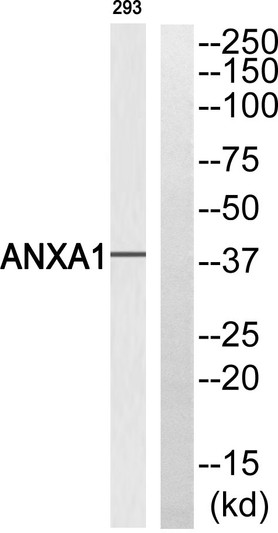| Post Translational Modifications | Phosphorylated by protein kinase C, EGFR and TRPM7. Phosphorylated in response to EGF treatment. Sumoylated. Proteolytically cleaved by cathepsin CTSG to release the active N-terminal peptide Ac2-26. |
| Function | Plays important roles in the innate immune response as effector of glucocorticoid-mediated responses and regulator of the inflammatory process. Has anti-inflammatory activity. Plays a role in glucocorticoid-mediated down-regulation of the early phase of the inflammatory response. Contributes to the adaptive immune response by enhancing signaling cascades that are triggered by T-cell activation, regulates differentiation and proliferation of activated T-cells. Promotes the differentiation of T-cells into Th1 cells and negatively regulates differentiation into Th2 cells. Has no effect on unstimulated T cells. Negatively regulates hormone exocytosis via activation of the formyl peptide receptors and reorganization of the actin cytoskeleton. Has high affinity for Ca(2+) and can bind up to eight Ca(2+) ions. Displays Ca(2+)-dependent binding to phospholipid membranes. Plays a role in the formation of phagocytic cups and phagosomes. Plays a role in phagocytosis by mediating the Ca(2+)-dependent interaction between phagosomes and the actin cytoskeleton. Annexin Ac2-26: Functions at least in part by activating the formyl peptide receptors and downstream signaling cascades. Promotes chemotaxis of granulocytes and monocytes via activation of the formyl peptide receptors. Promotes rearrangement of the actin cytoskeleton, cell polarization and cell migration. Promotes resolution of inflammation and wound healing. Acts via neutrophil N-formyl peptide receptors to enhance the release of CXCL2. |
| Protein Name | Annexin A1Annexin IAnnexin-1Calpactin IiCalpactin-2Chromobindin-9Lipocortin IPhospholipase A2 Inhibitory ProteinP35 Cleaved Into - Annexin Ac2-26 |
| Database Links | Reactome: R-HSA-416476Reactome: R-HSA-418594Reactome: R-HSA-444473Reactome: R-HSA-445355Reactome: R-HSA-6785807 |
| Cellular Localisation | NucleusCytoplasmCell ProjectionCiliumCell MembraneMembranePeripheral Membrane ProteinEndosome MembraneBasolateral Cell MembraneApical Cell MembraneLateral Cell MembraneSecretedExtracellular SpaceExtracellular SideExtracellular ExosomeCytoplasmic VesicleSecretory Vesicle LumenPhagocytic CupEarly EndosomeCytoplasmic Vesicle MembraneAt Least In Part Via Exosomes And Other Secretory VesiclesDetected In Exosomes And Other Extracellular VesiclesAlternativelyThe Secretion Is Dependent On Protein Unfolding And Facilitated By The Cargo Receptor Tmed10It Results In The Protein Translocation From The Cytoplasm Into Ergic (Endoplasmic Reticulum-Golgi Intermediate Compartment) Followed By Vesicle Entry And SecretionDetected In Gelatinase Granules In Resting NeutrophilsSecretion Is Increased In Response To Wounding And InflammationSecretion Is Increased Upon T-Cell ActivationNeutrophil Adhesion To Endothelial Cells Stimulates Secretion Via Gelatinase GranulesBut Foreign Particle Phagocytosis Has No EffectColocalizes With Actin Fibers At Phagocytic CupsDisplays Calcium-Dependent Binding To Phospholipid Membranes |
| Alternative Antibody Names | Anti-Annexin A1 antibodyAnti-Annexin I antibodyAnti-Annexin-1 antibodyAnti-Calpactin Ii antibodyAnti-Calpactin-2 antibodyAnti-Chromobindin-9 antibodyAnti-Lipocortin I antibodyAnti-Phospholipase A2 Inhibitory Protein antibodyAnti-P35 Cleaved Into - Annexin Ac2-26 antibodyAnti-ANXA1 antibodyAnti-ANX1 antibodyAnti-LPC1 antibody |
Information sourced from Uniprot.org











